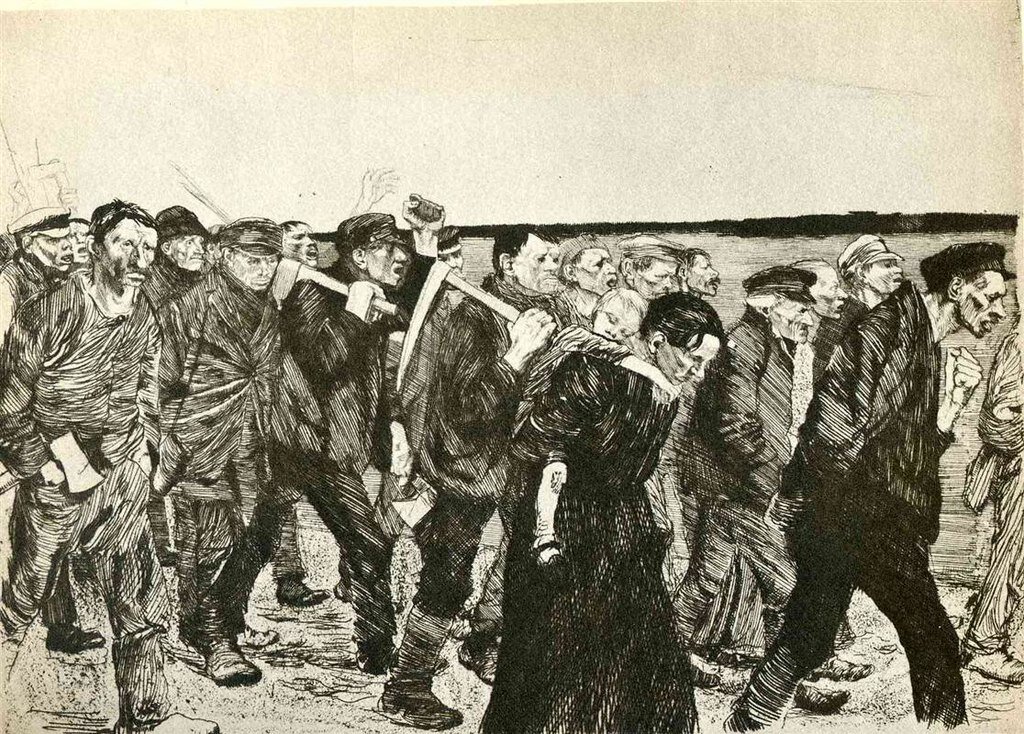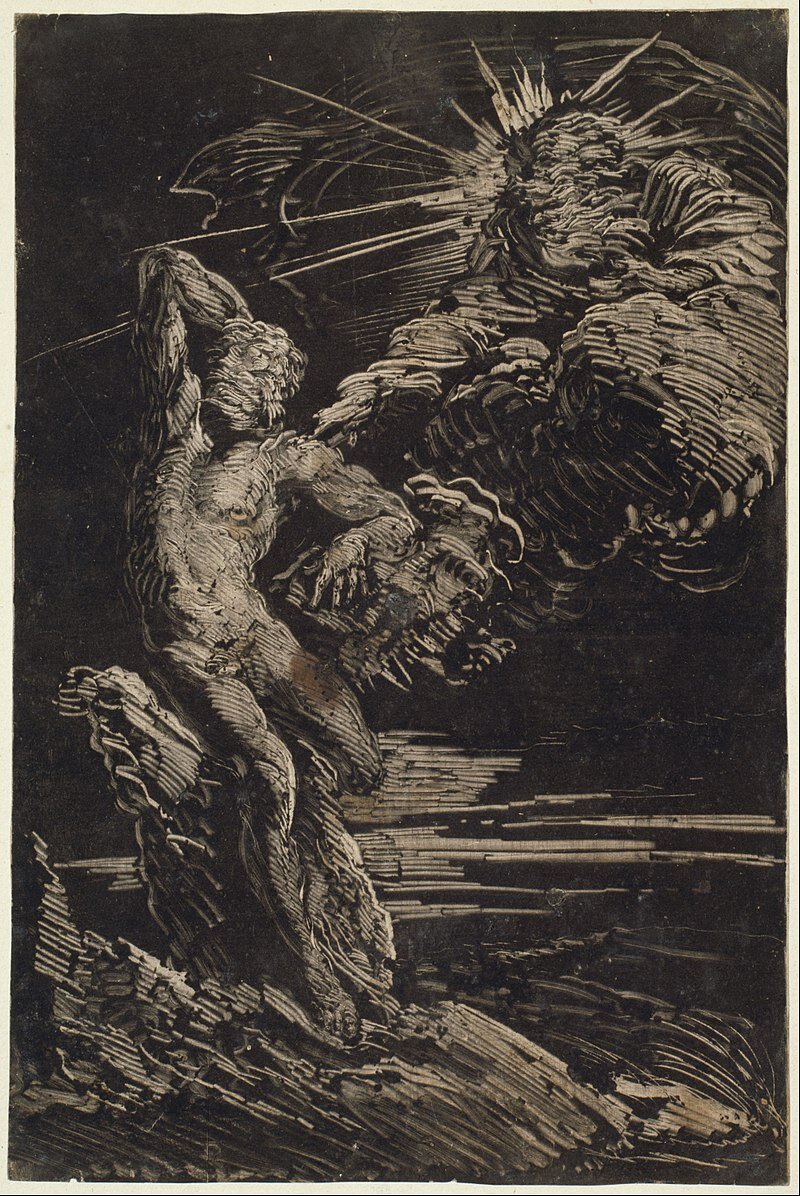Printmaking is the process of creating artworks by printing, normally on paper. Printmaking normally covers only the process of creating prints that have an element of originality, rather than just being a photographic reproduction of a painting.
In monotyping, the process is capable of producing multiples of the same piece, which is called a print.
Prints are created by transferring ink from a surface to a sheet of paper or other material, by a variety of techniques.
Common types of matrices include: metal plates (copper or zinc), polymer plates and other thicker plastic sheets for engraving or etching. Stone, aluminum, or polymer for lithography. Blocks of wood for woodcuts and wood engravings and Linoleum for linocuts.
Screens made of silk or synthetic fabrics are used for the screen printing process. Prints may also be printed in book form, such as illustrated books or artist's books.
Printmaking techniques are generally divided into the following basic categories:
1. Relief - Wood engraving, linocut and metalcut.
2. Intaglio - Engraving, etching, mezzotint, aquatint.
3. Planographic - Lithography, monotyping, digital techniques.
4. Stencil - screen printing and pochoir.
5. Collagraphy
6. Viscosity printing
Woodcut
Woodcut, a type of relief print, is the earliest printmaking technique, and the only one traditionally used in the Far East.
It was probably first developed as a means of printing patterns on cloth, and by the 5th century was used in China for printing text and images on paper.
The Underwave off Kanagawa, colour woodcut by Katsushika Hokusai
Process: A design is drawn on a plank of wood, or on paper which is transferred to the wood. Then use sharp tools to carve away the parts of the block that will not receive ink. The surface of the block is then inked with the use of a brayer, and then a sheet of paper, perhaps slightly damp, is placed over the block. The block is then rubbed with a baren or spoon, or is run through a printing press.
Reduction printing is a name used to describe the process of using one block to print several layers of color on one print.
This usually involves cutting a small amount of the block away, and then printing the block many times over on different sheets before washing the block, cutting more away and printing the next color on top.
Engraving
The process was developed in Germany in the 1430s from the engraving used by goldsmiths to decorate metalwork.
Engravers use a hardened steel tool called a burin to cut the design into the surface of a metal plate, traditionally made of copper. Engraving using a burin is generally a difficult skill to learn.
“Melencolia” engraving by Albrecht Durer
Process: Engravers use a hardened steel tool called a burin to cut the design. To make a print, the engraved plate is inked all over, then the ink is wiped off the surface, leaving only ink in the engraved lines.
The plate is then put through a high-pressure printing press together with a sheet of paper. The paper picks up the ink from the engraved lines, making a print.
Etching
Etching is part of the intaglio category. Although the first dated etching is by Albrecht Dürer in 1515, the process is believed to have been invented by Daniel Hopfer (c.1470–1536) of Augsburg, Germany
“The March of the Weavers in Berlin” etching by Kathe Kollwitz
Process: A metal plate (copper, zinc, or steel) is covered with a waxy or acrylic ground. The artist then draws through the ground with a pointed etching needle, exposing the metal. The plate is then etched by dipping it in a bath of etchant.
The etchant "bites" into the exposed metal, leaving behind lines in the plate. The remaining ground is then cleaned off the plate, and the printing process is then just the same as for engraving.
Etching prints are generally linear and often contain fine detail and contours. Lines can vary from smooth to sketchy. An etching is opposite of a woodcut in that the raised portions of an etching remain blank while the crevices hold ink.
Mezzotint
An intaglio variant of engraving in which the image is formed from subtle gradations of light and shade. Mezzotint—from the Italian mezzo ("half") and tinta ("tone")—is a "dark manner" form of printmaking, which requires artists to work from dark to light.
The mezzotint printmaking method was invented by Ludwig von Siegen (1609–1680). The process was used widely in England from the mid-eighteenth century, to reproduce oil paintings and in particular portraits.
“The Evening of the Deluge”, Mezzotint and engraving by John Martin
Process: To create a mezzotint, the surface of a copper printing plate is roughened evenly all over with the aid of a tool known as a rocker. The image is then formed by smoothing the surface with a tool known as a burnisher. When inked, the roughened areas of the plate will hold more ink and print more darkly, while smoother areas of the plate hold less or no ink, and will print more lightly or not at all.
It is, however, possible to create the image by only roughening the plate selectively, so working from light to dark.
Aquatint
“There is No One to Help Them”, aquatint by Francisco Goya
Process: Like etching, aquatint technique involves the application of acid to make marks in a metal plate. Where the etching technique uses a needle to make lines that retain ink, aquatint relies on powdered rosin which is acid resistant in the ground to create a tonal effect.
The rosin is applied in a light dusting by a fan booth, the rosin is then cooked until set on the plate. At this time the rosin can be burnished or scratched out to affect its tonal qualities. The tonal variation is controlled by the level of acid exposure over large areas, and thus the image is shaped by large sections at a time.
Lithography
It is a technique invented in 1798 by Alois Senefelder and based on the chemical repulsion of oil and water. Lithography is known for its ability to capture fine gradations in shading and very small detail.
Lithography technique by Toulouse Lautrec
Process: A porous surface, normally limestone, is used; the image is drawn on the limestone with a greasy medium. Acid is applied, transferring the grease-protected design to the limestone, leaving the image 'burned' into the surface.
Gum arabic, a water-soluble substance, is then applied, sealing the surface of the stone not covered with the drawing medium. The stone is then 'rolled up', oil ink is applied with a roller covering the entire surface.
Since water repels the oil in the ink, the ink adheres only to the greasy parts, perfectly inking the image. A sheet of dry paper is placed on the surface, and the image is transferred to the paper by the pressure of the printing press.
Screenprinting
Screen printing may be adapted to printing on a variety of materials, from paper, cloth, and canvas to rubber, glass, and metal. Artists have used the technique to print on bottles, on slabs of granite, directly onto walls, and to reproduce images on textiles which would distort under pressure from printing presses.
Process: The essential tools required are a squeegee, a mesh fabric, a frame, and a stencil.
Screen printing (also known as "silkscreen" or "serigraphy") creates prints by using a fabric stencil technique; ink is simply pushed through the stencil against the surface of the paper, most often with the aid of a squeegee.
Generally, the technique uses a natural or synthetic 'mesh' fabric stretched tightly across a rectangular 'frame,' much like a stretched canvas. The fabric can be silk, nylon monofilament, multifilament polyester, or even stainless steel.
Monotyping
Monotyping is a type of printmaking made by drawing or painting on a smooth, non-absorbent surface.
The surface was historically a copper etching plate, but in contemporary work it can vary from zinc or glass to acrylic glass.
Monotypes are the most painterly method among the printmaking techniques, a unique print that is essentially a printed painting.
Monotype technique by Giovanni Benedetto Castiglione
Process: The image is then transferred onto a sheet of paper by pressing the two together, usually using a printing-press. It can also be created by inking an entire surface and then, using brushes or rags, removing ink to create a subtractive image.
For example creating lights from a field of opaque color. The inks used may be oil based, the paper may be dry, in which case the image has more contrast, or the paper may be damp, in which case the image has a 10 percent greater range of tones.
Monoprinting
Monoprinting is a form of printmaking that uses a matrix such as a woodblock, litho stone, or copper plate, but produces impressions that are unique.
Monoprint technique
Process: There are many techniques used in monoprinting, including collagraph, collage, hand-painted additions, and a form of tracing by which thick ink is laid down on a table, paper is placed on the ink, and the back of the paper is drawn on, transferring the ink to the paper.
Monoprints can also be made by altering the type, color, and viscosity of the ink used to create different prints. Traditional printmaking techniques, such as lithography, woodcut, and intaglio, can be used to make monoprints.
Mixed media prints
Mixed-media prints may use multiple traditional printmaking processes such as etching, woodcut, letterpress, silkscreen, or even monoprinting in the creation of the print.
They may also incorporate elements of collage, or painted areas, and may be unique. Mixed-media prints are often experimental prints and may be printed on unusual, non-traditional surfaces.
Digital prints
Images are printed using digital printers such as inkjet printers instead of a traditional printing press. Images can be printed to a variety of substrates including paper, cloth, or plastic canvas.
Are you fascinated with these Printmaking techniques? Would you like to give it try?
References:
Printmaking - Wikipedia
www.smartartbox.com
www.metmuseum.org
www.artsy.net








